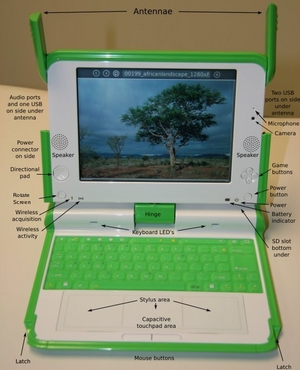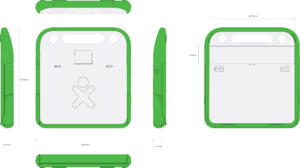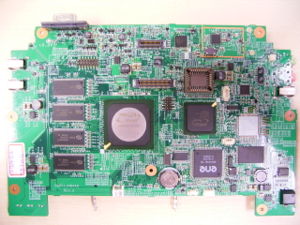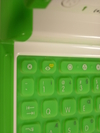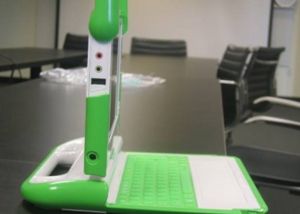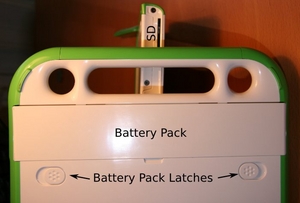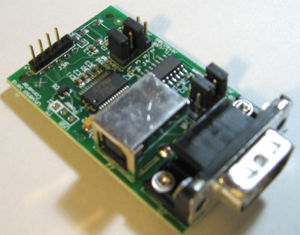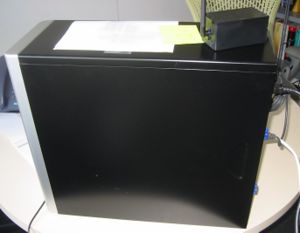Hardware specification
| deutsch | english | español | français | italian | 日本語 | 한글 | português | русский indonesia | HowTo [ID# 143681] +/- |
Contents
- 1 Laptop Hardware
- 1.1 Repair Parts List
- 1.2 Specifications
- 1.3 Laptop Development Schedule
- 1.3.1 Mass Production Systems
- 1.3.2 Preproduction Test Systems (CTest-2, or C2)
- 1.3.3 Preproduction Test Systems (CTest-1, or C1)
- 1.3.4 Beta Test 4 Systems (BTest-4, or B4)
- 1.3.5 Beta Test 3 Systems (BTest-3, or B3)
- 1.3.6 Beta Test 2 Systems (BTest-2, or B2)
- 1.3.7 Beta Test 1 Systems (BTest-1)
- 1.3.8 Pre-BTest boards
- 1.3.9 Alpha Test Prototype Electronics
- 1.3.10 Software on the development systems
- 1.4 See also
- 2 School Server Hardware
- 3 Active Antenna
Laptop Hardware
The XO laptop is a central focus of One Laptop Per Child. After three years of development, it is in mass production, with tens of thousands of units deployed in the field, and thousands more with developers and for testing in schools all over the world.
Repair Parts List
A complete Repair Parts List is under development.
Specifications
The definitive laptop specification is only available in PDF format. This page attempts to accurately reflect that information.
Physical dimensions
- Approximate dimensions: 242mm × 228mm × 32mm (see drawing to the right for detailed dimensions)
- Approximate weight:
- XO laptop with LiFePO4 battery: 1.45KG (~3.20lbs);
- XO laptop with NiMH battery: 1.58KG (~3.48lbs);
- Configuration: Convertible laptop with pivoting, reversible display; dirt- and moisture-resistant system enclosure; no fan.
Core electronics
- CPU: x86-compatible processor with 64KB each L1 I and D cache; at least 128KB L2 cache;
- CPU clock speed: 433 Mhz;
- i586 instruction set (including MMX and 3DNow! Enhanced) with additional Geode-specific instructions
- Companion chips: PCI and memory interface integrated with CPU;
- Graphics controller: Integrated with CPU; unified memory architecture;
- Embedded controller: ENE KB3700 or ENE KB3700B;
- DRAM memory: 256 MiB dynamic RAM; data rate: dual-DDR333-166Mhz;
- BIOS: 1024KiB SPI-interface flash ROM;
- Open Firmware used to load the operating system;
- Mass storage: 1024 MiB SLC NAND flash, high-speed flash controller;
- Drives: No rotating media.
- CAFE ASIC (camera- and flash-enabler chip provides high-performance camera, NAND FLASH and SD interfaces); Marvell 88ALP01: CAFE Specification
Display
- Liquid-crystal display: 7.5” dual-mode TFT display;
- Viewing area: 152.4 mm × 114.3 mm;
- Two modes: (1) grayscale (B&W) reflective mode (for outdoor use—sunlight-readable); and (2) color backlight Mode (for indoor use);
- reflective mode: high-resolution (200 DPI), 1200(H) × 900(V) grayscale pixels, power consumption 0.1–0.2Watts;
- backlight mode: built in sub-pixel sampling of the high-resolution display results in approximately 984(H) × 738(V) color pixels, power consumption 0.2–1.0Watts;
- The display-controller chip (DCON) with memory that enables the display to remain live with the processor suspended. The DCON also formats data for the display.
- This Liquid-crystal display is the basis of our extremely low power architecture. The XO is usable while the CPU and much of the motherboard is regularly turned off (and on) so quickly that it's imperceptible to the user. Huge power savings are harvested in this way (e.g. by turning stuff on the motherboard off when it's not being used (if even for a few seconds), while keeping the display on).
- Note: web browser images are currently scaled up so that an image of very roughly [800 × 600] fills up the browser window.
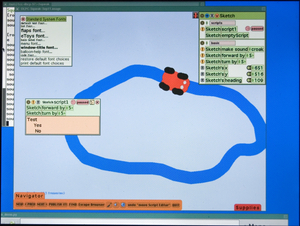
Integrated peripherals
- Keyboard: 80+ keys, 1.0mm stroke; sealed rubber-membrane key-switch assembly;
- Keyboard Layouts
- Layout pictures: English, Arabic, Thai, West African (Nigeria), Portuguese, Spanish, Amharic, French, Urdu, Cyrillic, Turkish (not final), Nepali, Mongolian, Kazakh, Devanagari, Uzbek, Pashto, Dari, Pulaar (Fula), Italian
- Gamepad: Two sets of four-direction cursor-control keys;
- Touchpad: Dual capacitance/resistive touchpad; supports written-input mode;
- ALPS Electric Dual capacitance/resistive touchpad;
- Audio: AC’97 compatible audio subsystem; Internal stereo speakers and amplifier; internal monophonic microphone; jacks for external headphones or microphone;
- Analog Devices AD1888 and Analog Devices SSM2302 for audio amplification
- Camera: integrated color video camera; 640 x 480 resolution at 30 FPS; independent (and undefeatable by software) display of microphone and camera recording status; the camera and device driver support disabling AGC and automatic color balancing, to enable its use as a photometric sensor for educational applications;
- Wireless Networking: Integrated 802.11b/g (2.4GHz) interface; 802.11s (Mesh) networking supported; dual adjustable, rotating antennas support diversity reception; capable of mesh operation when CPU is powered down;
- Status indicators: Power, battery, and WiFi (2), visible with lid open or closed; Microphone In-Use, and Camera In-Use, visible when lid is open.
External connectors
- DC power: 6mm (1.65mm center pin) connector; 11 to 18 V input usable, –32 to +40V input tolerated; power draw limited to 18 W; - see power connector dimensions at Battery and power.
- Headphone output: standard 3.5mm 3-pin switched stereo audio jack;
- Microphone input: standard 3.5mm 2-pin switched mono microphone jack; selectable 2V DC bias; selectable sensor-input mode (DC or AC coupled);
- USB: Three Type-A USB 2.0 connectors; Up to 1A power supplied (total);
- Flash Expansion: SD Card slot.
Battery
- Pack type: 2 or 4 cells LiFePO4; or 5 cells NiMH, approx. 6V series configuration (subject to change);
- Capacity: 16.5 Watt-hours (NIMH), 22 Watt-hours (LiFeP);
- Fully-enclosed “hard” case; user removable;
- Electronics integrated with the pack provide:
- Identification;
- Battery charge and capacity monitoring chip (Maxim DS2756 data sheet);
- Thermal and over-current sensors along with cutoff switch to protect battery;
- Minimum 2,000 charge/discharge cycles (to 50% capacity of new).
- Power Management will be critical
See also LX Power Measurements#The Numbers.
BIOS/loader
- Open Firmware (including hardware initialization and fast resume).
Environmental specifications
- Temperature: UL certification planned to 45C in Q32007, pending 50C certification in mid-2008;
- Humidity: UL certification planned to IP42 (perhaps higher) when closed, the unit should seal well enough that children walking to and from school need not fear rainstorms and dust;
- Maximum altitude: –15m to 3048m (14.7 to 10.1 PSIA) (operating), –15m to 12192m (14.7 to 4.4 PSIA) (non-operating);
- Shock 125g, 2ms, half-sine (operating) 200g, 2ms, half-sine (non-operating);
- Random vibration: 0.75g zero-to-peak, 10Hz to 500Hz, 0.25 oct/min sweep rate (operating); 1.5g zero-to-peak, 10Hz to 500Hz, 0.5 oct/min sweep rate (nonoperating);
- 2mm plastic walls (1.3mm is typical for most systems).
Regulatory requirements
- The usual US and EU EMI/EMC (electromagnetic-interference and electromagnetic-compatibility) requirements will be met;
- The laptop meets IEC 60950-1, EN 60950-1, and CSA/UL 60950-1 specifications. It also complies with UL 1310 and UL 498. In order to guarantee the safety of children using the laptop, it passes ASTM F 963;
- The external power adapter complies with IEC, EN, and CSA/UL 60950-1;
- The removable battery pack complies with IEC, EN, and CSA/UL 60950-1 and UL 2054;
- RoHS (Restriction of Hazardous Substances Directive – EU) compliant.
Support Hardware
Serial Adapter (for developers)
Laptop Development Schedule
Mass Production Systems
Started November 2007.
Preproduction Test Systems (CTest-2, or C2)
Pre-build of 50 motherboards in October to test last minute changes.
Preproduction Test Systems (CTest-1, or C1)
This build is of 300 laptops produced as a test of the manufacturing process on the main production line, and should happen starting August 6th, 2007. Slip resistance rubber feet will be added as will more easily replaceable bunny ears (just two screws per ear after bezel removal). The hinge stop that appeared in B3/B4 will be eliminated or reduced (this is used to the stop the display at perpendicular before it tilts back further). Bean texture will be applied to the exterior white parts and "satin" texture to the the rest of the laptop plastic parts. A C1 laptop will be nearly identical to the production unit ...
Preproduction Test Systems have a label under the battery that says C-TEST-SAMPLE.
Beta Test 4 Systems (BTest-4, or B4)
This build which ran from June 20-25, 2007, was the final chance to fix hardware and mechanical problems that were detected in the Beta Test 3 build of the XO. 2000 units were built.
Texture was added to the upper handle bar, the hinge tilt was increased by 7 degrees, the hinge "squeak" was eliminated, the rabbit ears click in place when put in the "down" position", the slight camera vignetting seen in B3 was eliminated, and minor modifications were made to the motherboard.
Beta Test 4 Systems have a label under the battery that says B4-TEST-SAMPLE.
Beta Test 4 Systems work with current software releases. They may experience hardware problems with extensive suspend/resume or low battery, and the software therefore tries to minimize suspend/resume cycles on B4's.
Beta Test 3 Systems (BTest-3, or B3)
This build—May 2007—is the first to use an updated design for the laptop. It was the first build providing the processor and memory capabilities of the production version. Noticeable improvements over BTest-2 include:
- A faster, lower power processor: the Geode LX-700
- 64 KB I/64 KB D of L1 Cache, 128 KB of L2 Cache (vs. 32 KB of L1 cache)
- Faster processor and memory clock (433/333 vs. 366/266)
- 1.5 W typ. vs. 3 W typ.
- Much better graphics processor, including support for rotated blits and depth conversion
- More memory: 256 MB of SDRAM (vs. 128 MB)
- extra screws
- insert molded rubber ears for better robustness
- a smaller battery cavity to improve robustness, make the bumper lines clearer
- 10-20V input voltage tolerance.
- new bumper tooling to allow the bumpers to be made of polycarbonate (as opposed to PC/ABS) with 3mm thickness and ribbing to 1.8mm (was 2mm and 1.2mm respectively)
- colored XO on the back cover (400 different color combinations so kids can distinguish their laptops from each other
- A keyboard that is much better to type on
- Finally a touchpad that is much easier to use and much more responsive
- a steel plate inside the entire keyboard base to reduce the feeling of flimsiness
- a flipped USB connector so each side has the same way up for a USB key or device
- A new hinge design allows greater tilt of the screen
- An improved case design (addressing strength)
A very small number of BTest-3 units (around a hundred) were built, all were used for hardware and low level software development.
Beta Test 3 Systems have a label under the battery that says B3-TEST-SAMPLE.
Beta Test 3 Systems work with current software releases. They may experience hardware problems with extensive suspend/resume or low battery, and the software therefore tries to minimize suspend/resume cycles on B3's.
Beta Test 2 Systems (BTest-2, or B2)
Approximately 2500 systems were built by Quanta and distributed. These are fully functional machines with CaFE ASICs, and reflect some, but not all of the learning and improvements from testing of BTest-1. Much more information about the BTest-2 systems can be found in the BTest-2 Release Notes. Some of the details of the hardware design are to support the OLPC Human Interface Guidelines.
BTest-2 systems are almost identical visually with BTest-1. BTest-3 has more substantial physical differences. An easy way to tell the difference between BTest-1 and BTest-2 is that BTest-1 keyboards have white lettering, and BTest-2 has black lettering.
There are two flavors of B2. Beta Test 2-1 (B2-1) systems, which only have 128 MB of memory, have a label under the battery that says B2-TEST-SAMPLE and a label that says B2-#, where # is one to 16. Beta Test 2-2 (B2-2) systems, which have 256MB of memory, have a label under the battery that says B2-7-ext.
Beta Test 2-1 laptops do not perform well with current software releases.
Beta Test 1 Systems (BTest-1)
Approximately 875 systems were built by Quanta in November 2006 and distributed. The BTest-1 systems were fully functional machines (compared to a BTest-2 system), but built before the custom integrated circuits were available. An Altera FPGA is used in place of the CaFE ASIC which is present in later builds, for NAND flash, camera, and SD interfaces. This FPGA has lower performance and consumes much more power than the CaFE ASIC does. Much more information about the BTest-1 systems can be found in the BTest-1 Release Notes. (Beta Test 1 Systems have a label under the battery that says B1-TEST-SAMPLE.)
BTest-1 and pre-BTest systems are no longer supported by our current software releases.
Pre-BTest boards
A small number of pre-BTest boards were built in preparation for building complete BTest systems. Developer information about B-test boards are here.
Alpha Test Prototype Electronics
Power up of the first OLPC electronics prototype boards occurred April 15, 2006. Power and ground testing continued over the weekend, and formal debug and BIOS bring up started Monday, April 17, 2006 at Quanta Computer's labs in Taipei, Taiwan. By Wednesday, April 19, Linux was booting on the first generation prototypes.
Photographs:
- Component side OLPC circuit board
- Back side of the OLPC circuit board
- Picture of Linux running with circuit board in the lab
- Picture of the screen of Linux running on the OLPC circuit board; fittingly, it shows a Chinese desktop
ATest systems are no longer supported by our current software releases.
Software on the development systems
C2:
- Everything works with the exception of a few items in Trac and any yet to be discovered bugs;
C1/B4/B3:
- There may be occasional crashes (possibly made worse by suspend/resume) when the battery is running low. Above 25% of capacity, or plugged into a power adapter, you should be OK ([1]);
- There may be times when the WLAN (USB) hangs (possibly made worse by suspend/resume) ([2], [3]);
- Power cycling the DCON is liable to crash the laptop. This power cycling will occasionally happen in response to a DCON bug triggered by suspend/resume ([4]);
- Rare crashes may be caused by other sources during suspend/resume (Camera, SD card, clock settling time), some units (especially B3s) may be more sensitive than others ([5]);
B2:
- All of the problems listed for C1/B4/B3 are present;
- The keyboard/touchpad may not be used to wakeup from a suspend/resume ([6]);
- The DCON will glitch coming out of suspend/resume ([7]);
- The camera will not work properly;
A:
- A Test is no longer supported. Do not load D- or C-series firmware on A Test machines.
See also
Formerly part of this page:
See also:
- Hardware Testing: Safety Certifications and Robustness
- Hardware
- Support
- The definitive laptop specification (only available in PDF format).
School Server Hardware
While the laptop is rightfully at the center of OLPC, a valuable peripheral is the school server. OLPC will be building and distributing school servers along with the laptops, to extend the storage and computation provided by each laptop, as well as providing a local library and a mesh portal to the Internet.
Unlike the laptop, the school server is more of a collection of services than a hardware platform. In a manner identical to the laptop, OLPC will collaborate with manufacturing partners to provide a cost-efficient hardware platform for running the recommended software. Unlike the laptop, the manufacturing collaboration will not be exclusive. Individual countries will be free (even encouraged) to design and manufacture their own school servers running derivatives of the OLPC school server software.
XS
This will be the school server designed by OLPC. It is mostly designed, but currently on hold as we reconsider manufacturers, and should reach early production volumes in spring 2008. See the specification.
XSX
This is a prototype school server, built for early school trials in country. It will be integrated from off-the-shelf components, and will be overpowered compared to a production school server in order to simplify early demands for system software. See the specification and the implementation.
Active Antenna
The active antennae used in the school-server configurations are the same as the Marvell radios in the XO laptops:
- Connection: USB
- Cable length: 5m
- Power: 5V @ 800mA
